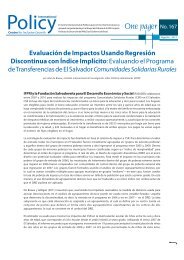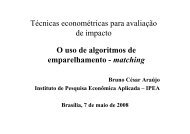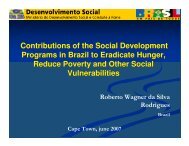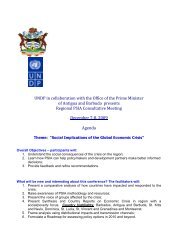Paper - International Policy Centre for Inclusive Growth
Paper - International Policy Centre for Inclusive Growth
Paper - International Policy Centre for Inclusive Growth
You also want an ePaper? Increase the reach of your titles
YUMPU automatically turns print PDFs into web optimized ePapers that Google loves.
plight of São Paulo’s population in 2000 analyzing the level of deprivation suffered by its<br />
inhabitants.<br />
The measurement of deprivation in a society has traditionally been conducted analyzing<br />
incomes of individuals, as income summarizes command over resources and is an index<br />
of the individual’s ability to consume commodities. In this framework a seminal paper<br />
is that by Yitzhaki (1979) where it is suggested that an appropriate index of aggregate<br />
deprivation is the absolute Gini index. Hey and Lambert (1980) provide an alternative<br />
motivation of Yitzhaki’s result. Duclos (2000) shows that a generalization of Gini, the<br />
class of S-Ginis, could be interpreted as indices of relative deprivation.<br />
A reason <strong>for</strong> being interested in deprivation is its representation of the degree of<br />
discontent or injustice felt by the members of a society. In view of this fact, Podder (1996)<br />
criticizes the measure of deprivation proposed in the literature and discusses the reasons<br />
why these are unable to capture the phenomenon. Deprivation and inequality are different<br />
concepts, hence an index of inequality, such as the Gini coefficient, is inappropriate to<br />
measure deprivation. In Podder (1996) the distinction between the two is explained by<br />
their relations to envy. “We say that a person i has a feeling of envy towards person j<br />
if he prefers to exchange his consumption bundle with that of person j” Podder (1996,<br />
p.356). Deprivation is proportional to the feeling of envy towards the better off. Equity—<br />
the absence of inequality—is the absence of envy in all economic agents. At the same<br />
time, equity coincides with minimum deprivation—all individuals possess the same level<br />
of income. In constrast, the upper bounds of deprivation and inequality do not coincide.<br />
Maximum inequality is reached when one individual monopolizes the entire total income;<br />
maximum deprivation <strong>for</strong> Podder, on the other hand, is obtained when the society is<br />
polarized in two equal-sized groups, those possessing income and those not possessing it.<br />
An analogous distinction with inequality is at the basis of the concept of polarization<br />
of Esteban and Ray (1994). In a companion paper, Esteban and Ray (1999) link social<br />
tension and conflict to polarization. The proposed measure of polarization is a variation<br />
of the Gini coefficient, where not only alienation pays a role, that is the symmetric gaps<br />
of income that are at the heart of the Gini index, but also identification with identical<br />
individuals, which is inexistent in the Gini coefficient. Following the Esteban and Ray<br />
identification/alienation framework, Bossert, D’Ambrosio and Peragine (2005) proposed<br />
an alternative index of deprivation. (See Section 2 <strong>for</strong> a detailed description of these<br />
indices).<br />
In this paper we compare deprivation in the districts of São Paulo in 2000 using the<br />
absolute Gini coefficient, the polarization index of Esteban and Ray (1994) and the de-<br />
2








